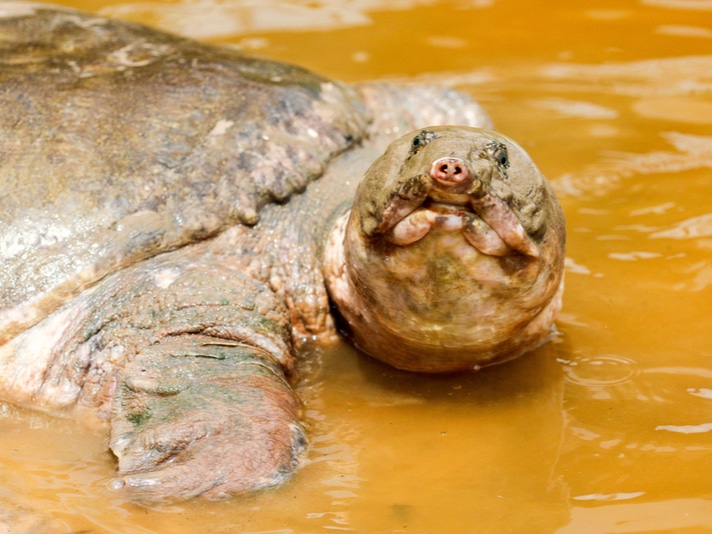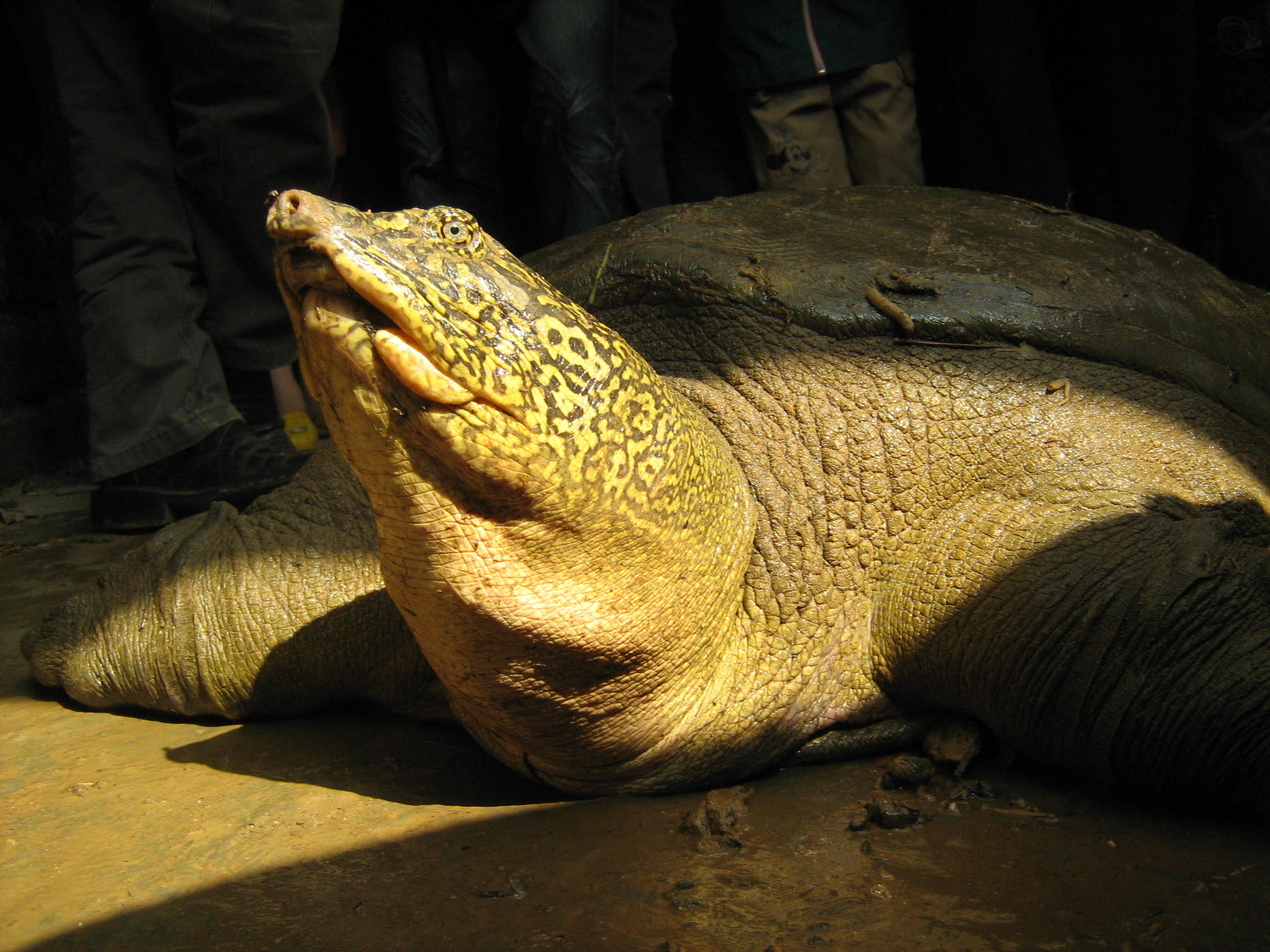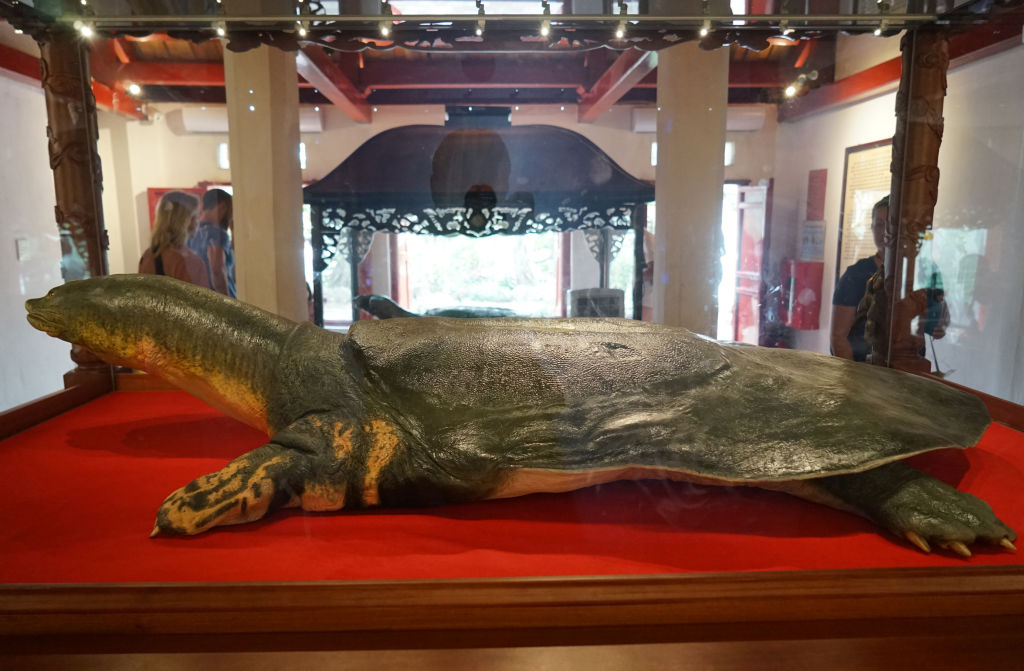Last Known Female Yangtze Giant Softshell Turtle Dies

John Virata May 1, 2023
The last known female Yangtze giant softshell turtle has died. She was found at Hoan Kiem Lake in Hanoi, Vietnam, April 23, Conservationist Forrest Galante announced in a video on social media.
“I am still in just such belief that yesterday, we literally witnessed the loss of one of the planet’s true gigantic species, the Yangtze giant softshell turtle,” Galante wrote on Facebook. “It’s just devastating. Humans must learn from this and try to do better as docents of our planet.”

This is an Asian giant softshell turtle, the same family, Trionychidae as the Yangtze giant softshell. It is also critically endangered. Photo by evenfh/Shutterstock
Galante worked with the turtle in 2020, participating in an eDNA analysis of the turtle with the Asian Turtle Program, which confirmed her gender.
There are just two known Yangtze giant softshell turtles left. Both are living in a zoo in China. Galante noted that the male has a broken penis and is unable to reproduce, garnering this species functionally extinct.
Scientists Try To Impregnate Last Female Yangtze Giant Softshell Turtle Known To Exist
Sacred Turtle Of Vietnam Has Died
The turtle who died was discovered in Vietnam’s Dong Mo Lake in 2021. Prior to her discovery, a female named China Girl, at the Suzhou Zoo in China was the last known female. She died in 2019.
Yangtze Giant Softshell Turtle Information
The Yangtze giant softshell turtle, also known as the Hoan Kiem turtle or Swinhoe’s softshell turtle, is native to China and Vietnam. There are only two known living individuals, both living in captivity. The species is now functionally extinct, unless a female in the wild is located and successfully bred. It can grow to six feet in length and weigh upward of 500 lbs. Yangtze giant softshell turtles are critically endangered. The population of this species has dropped drastically due to hunting, habitat loss, and change in environments for rice production. There is the potential that this species may be found in larger more isolated lakes.
An Extremely Rare, Revered Reptile Is on the Brink of Extinction After Last Female Dies
The turtle who died was discovered in Vietnam’s Dong Mo Lake in 2021.
John Virata May 1, 2023
The last known female Yangtze giant softshell turtle has died. She was found at Hoan Kiem Lake in Hanoi, Vietnam, April 23, Conservationist Forrest Galante announced in a video on social media.
“I am still in just such belief that yesterday, we literally witnessed the loss of one of the planet’s true gigantic species, the Yangtze giant softshell turtle,” Galante wrote on Facebook. “It’s just devastating. Humans must learn from this and try to do better as docents of our planet.”

This is an Asian giant softshell turtle, the same family, Trionychidae as the Yangtze giant softshell. It is also critically endangered. Photo by evenfh/Shutterstock
Galante worked with the turtle in 2020, participating in an eDNA analysis of the turtle with the Asian Turtle Program, which confirmed her gender.
There are just two known Yangtze giant softshell turtles left. Both are living in a zoo in China. Galante noted that the male has a broken penis and is unable to reproduce, garnering this species functionally extinct.
Scientists Try To Impregnate Last Female Yangtze Giant Softshell Turtle Known To Exist
Sacred Turtle Of Vietnam Has Died
The turtle who died was discovered in Vietnam’s Dong Mo Lake in 2021. Prior to her discovery, a female named China Girl, at the Suzhou Zoo in China was the last known female. She died in 2019.
Yangtze Giant Softshell Turtle Information
The Yangtze giant softshell turtle, also known as the Hoan Kiem turtle or Swinhoe’s softshell turtle, is native to China and Vietnam. There are only two known living individuals, both living in captivity. The species is now functionally extinct, unless a female in the wild is located and successfully bred. It can grow to six feet in length and weigh upward of 500 lbs. Yangtze giant softshell turtles are critically endangered. The population of this species has dropped drastically due to hunting, habitat loss, and change in environments for rice production. There is the potential that this species may be found in larger more isolated lakes.
Rare reptile of mythical lore — the last female of her species — dies in Vietnam

Anonymous/ASSOCIATED PRESS
Brendan Rascius
Tue, May 2, 2023
An extremely rare reptile, considered sacred by many, died recently in Vietnam, bringing its species to the edge of extinction.
The deceased creature was a Yangtze giant softshell turtle, distinguished by its large size and pig-like snout, according to VN Express, an online news outlet.
The 200-pound turtle died in a Hanoi lake of unknown causes, according to the outlet.
Tim McCormack, director of the Asian Turtle Program for Indo-Myanmar Conservation, told TIME that scientists believe the creature was the last known female of its species.
“I am truly heartbroken,” Forrest Galante, a biologist and television personality, wrote on Facebook, adding that the creature’s death leaves “only two known males remaining — one in Suzhou Zoo in China and another in Hanoi’s Xuân Khanh Lake.”
Galante is a conservationist who previously worked on an eDNA analysis of the turtle with the Asian Turtle Program, according to Reptiles Magazine.
The endangered reptile holds a mythical status in Vietnam because it features in a legend similar to that of England’s King Arthur, according to the International Society for the History and Bibliography of Herpetology.
The turtle is said to have delivered a magical sword to a king, which allowed him to repel invaders. Once the enemies were defeated, according to the legend, the turtle reappeared in a Hanoi lake and retrieved the weapon before vanishing beneath the surface.
The turtle is even worshiped by some, and when one of the last remaining individuals died in 2016, its remains were embalmed and put on display, according to Scientific American.
The species, which is only native to parts of China and Vietnam, began declining in the 1980s as a result of habitat loss and consumption, according to a study published in 2021 in the journal Oryx.
While there are now only officially two surviving members of the species, it’s possible more exist undetected in the wild. There have been over a dozen potential sightings of previously unknown turtles in recent years, according to the study.

Anonymous/ASSOCIATED PRESS
Brendan Rascius
Tue, May 2, 2023
An extremely rare reptile, considered sacred by many, died recently in Vietnam, bringing its species to the edge of extinction.
The deceased creature was a Yangtze giant softshell turtle, distinguished by its large size and pig-like snout, according to VN Express, an online news outlet.
The 200-pound turtle died in a Hanoi lake of unknown causes, according to the outlet.
Tim McCormack, director of the Asian Turtle Program for Indo-Myanmar Conservation, told TIME that scientists believe the creature was the last known female of its species.
“I am truly heartbroken,” Forrest Galante, a biologist and television personality, wrote on Facebook, adding that the creature’s death leaves “only two known males remaining — one in Suzhou Zoo in China and another in Hanoi’s Xuân Khanh Lake.”
Galante is a conservationist who previously worked on an eDNA analysis of the turtle with the Asian Turtle Program, according to Reptiles Magazine.
The endangered reptile holds a mythical status in Vietnam because it features in a legend similar to that of England’s King Arthur, according to the International Society for the History and Bibliography of Herpetology.
The turtle is said to have delivered a magical sword to a king, which allowed him to repel invaders. Once the enemies were defeated, according to the legend, the turtle reappeared in a Hanoi lake and retrieved the weapon before vanishing beneath the surface.
The turtle is even worshiped by some, and when one of the last remaining individuals died in 2016, its remains were embalmed and put on display, according to Scientific American.
The species, which is only native to parts of China and Vietnam, began declining in the 1980s as a result of habitat loss and consumption, according to a study published in 2021 in the journal Oryx.
While there are now only officially two surviving members of the species, it’s possible more exist undetected in the wild. There have been over a dozen potential sightings of previously unknown turtles in recent years, according to the study.

A female Giant Yangtze Softshell Turtle, which died in 2023, in Hanoi in 2008.
Courtesy of Tim McCormack—Asian Turtle Program
APRIL 28, 2023
A dark oblong creature drifted from the depths of Hanoi’s 1,400-hectare Đồng Mô Lake and began to float, motionless, on the surface last weekend. Local residents and conservationists locked eyes on the gloomy sight, sharing fears about what this might mean for the future of a revered species in Vietnam.
On Monday, state media reports suggested it was not only a Giant Yangtze Softshell Turtle (Rafetus swinhoei), but it was likely the last known female of the species, leaving only two known males remaining—one in Suzhou Zoo in China and another in Hanoi’s Xuân Khanh Lake.
Speaking to TIME on Friday, Tim McCormack, director of the Asian Turtle Program for Indo-Myanmar Conservation, confirmed that the creature was almost certainly the last known female Rafetus swinhoei: “It is the same individual that we’ve been monitoring in recent years. It’s a real blow,” he said, noting that local authorities will soon complete a genetic test of the carcass to verify its identity. “It was a large female that obviously has great reproductive capacity. She could have potentially laid a hundred eggs or more a year.”
News reports suggest that the reptile, which is 156 centimeters long and weighs 93 kilograms, could have died days before it was spotted by locals. The cause of death remains unknown, as local authorities are yet to carry out a full autopsy.
The discovery of the female in January 2021 had raised hopes that the species could be saved from extinction. The reptile, also known as the Hoàn Kiếm turtle, has been driven to the brink of disappearance by rising levels of pollution as well as decades of hunting for its meat and eggs.
Previously, there was another female Giant Yangtze Softshell Turtle in Suzhou Zoo in China, but it died amid breeding efforts in 2018. For many years, staff tried unsuccessfully to get the pair of turtles at the zoo to reproduce naturally.

A female Giant Yangtze Softshell Turtle, which died during an insemination operation in 2019, surfaces for sunshine at the Suzhou Zoo in east China's Jiangsu province, Nov. 05, 2014.
FeatureChina/AP
“The whole time, in 20 years I’ve been working with the species, we’ve never seen any eggs,” McCormack added. “There has been an artificial nesting beach built in Đồng Mô Lake for almost 10 years now, which has had no nesting. So one of the questions has been whether this was a lone animal or whether there are other animals in Đồng Mô.”
According to the Asian Turtle Program, there may be another Rafetus swinhoei living in Đồng Mô Lake, which gives conservationists reason to not give up on the species yet. But to date, scientists have only managed to catch and identify the one female.
“We’re also working at Xuân Khanh Lake in Hanoi, where environmental DNA has confirmed there is a male Rafetus,” McCormack said, adding that there is a need to capture and identify the reptile.
A revered creature
The Hoàn Kiếm turtle is of great spiritual importance in Vietnam. In the 15th century, according to Vietnamese mythology, a turtle in Hoàn Kiếm Lake gifted a sword to emperor Lê Lợi, which he used to vanquish occupying Chinese forces.
Khoi Pham, the editor of arts and culture magazine Saigoneer, tells TIME: “The fact that Rafetus swinhoei’s natural habitat overlaps with the story’s location elevates the species’ cultural significance in the eyes of Vietnamese. It’s like we have a tangible connection to history right in our backyard, and seeing the turtle alive and kicking makes the legends seem more real and our past victories more validated.”
Sightings of Rafetus swinhoei have proved a rare occurrence in recent years. One YouTube video recorded in March 2011 shows a crowd thronging one side of Hanoi’s Hoàn Kiếm Lake. A palpable sense of awe spreads among the gathering as they stare expectantly at the grimy water, hoping to catch a glimpse of the famed Cụ Rùa, the honorific given to the last Giant Yangtze Softshell Turtle in Hoàn Kiếm Lake. Slowly, tentatively, the huge beast emerged, viciously shredding a dead cat in its jaws before sinking back down into the murky depths. The crowd was utterly jubilant, shrieking in delight.
When Cụ Rùa died in January 2016, Hanoians mourned its passing. Some also saw its death as a bad omen for the ruling Communist Party, which was about to kick off its five-yearly National Congress.

The embalmed body of the legendary Giant Yangtze Softshell Turtle Cu Rua is exhibited in the Ngoc Son temple in Hanoi, March 21, 2019. Until his death in January 2016, the turtle was worshipped as the last descendant of the mythical turtle god Kim Quy.
Bennett Murray—dpa/picture alliance/Getty Images
“Turtles have long been revered in Vietnamese culture as a symbol of longevity, wisdom, and stability. The creatures appear as decorative motifs in temples and monuments, and as mythological figures in many folk legends,” added Khoi. “It’s a shame that, for a country that respects turtle deities so much, we have been doing such a poor job of protecting their real-life counterparts.”
Its polluted habitat
Rafetus swinhoei were once abundant in the rivers and lakes of northern Vietnam, yet growing levels of pollution have gravely degraded their natural habitat.
Practically all of Hanoi’s lakes are heavily contaminated due to a deadly combination of industrial and residential wastewater, dumped trash, and invasive algae. AND THE TOXIC CHEMICALS FROM THE VIET NAM WAR DROPPED BY AMERICANS
“In general, a healthy environment leads to healthy individuals. Đồng Mô Lake is a large water body, so therefore is less likely to be polluted compared to smaller bodies,” said McCormack. “The one in central Hanoi, Hoàn Kiếm Lake, was very polluted.”
Although the loss of the female Rafetus swinhoei in Đồng Mô Lake has shocked and saddened conservationists, some hope remains.
“I do think there’s more out there,” McCormack said. “I do think there’s still hope for the species, but the loss of a large female is very sad.”
“There are tissue samples being preserved from the Hoàn Kiếm turtle,” he added. “That’s potential for the future, but ideally we should be protecting what we’ve got now.”
No comments:
Post a Comment